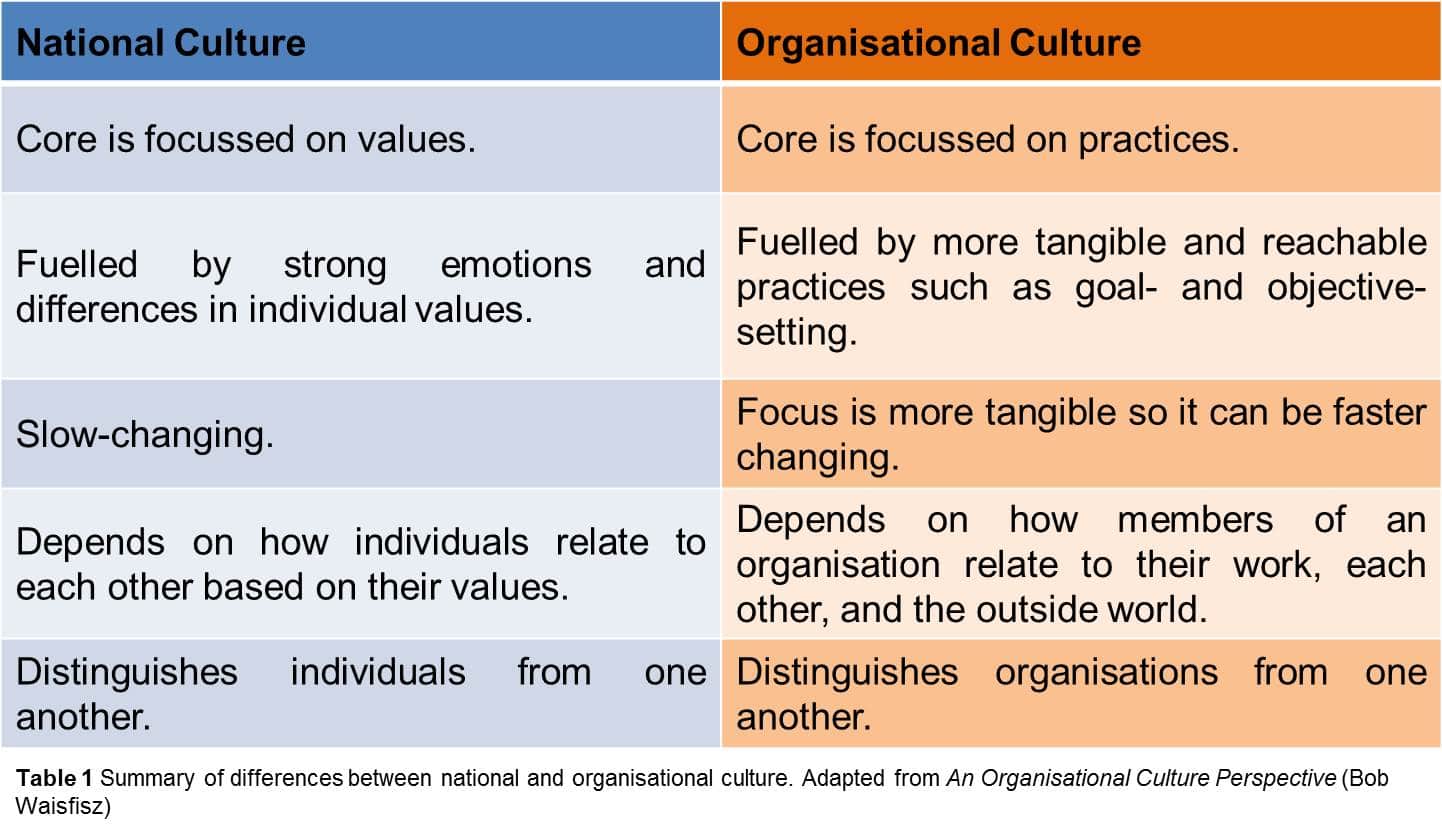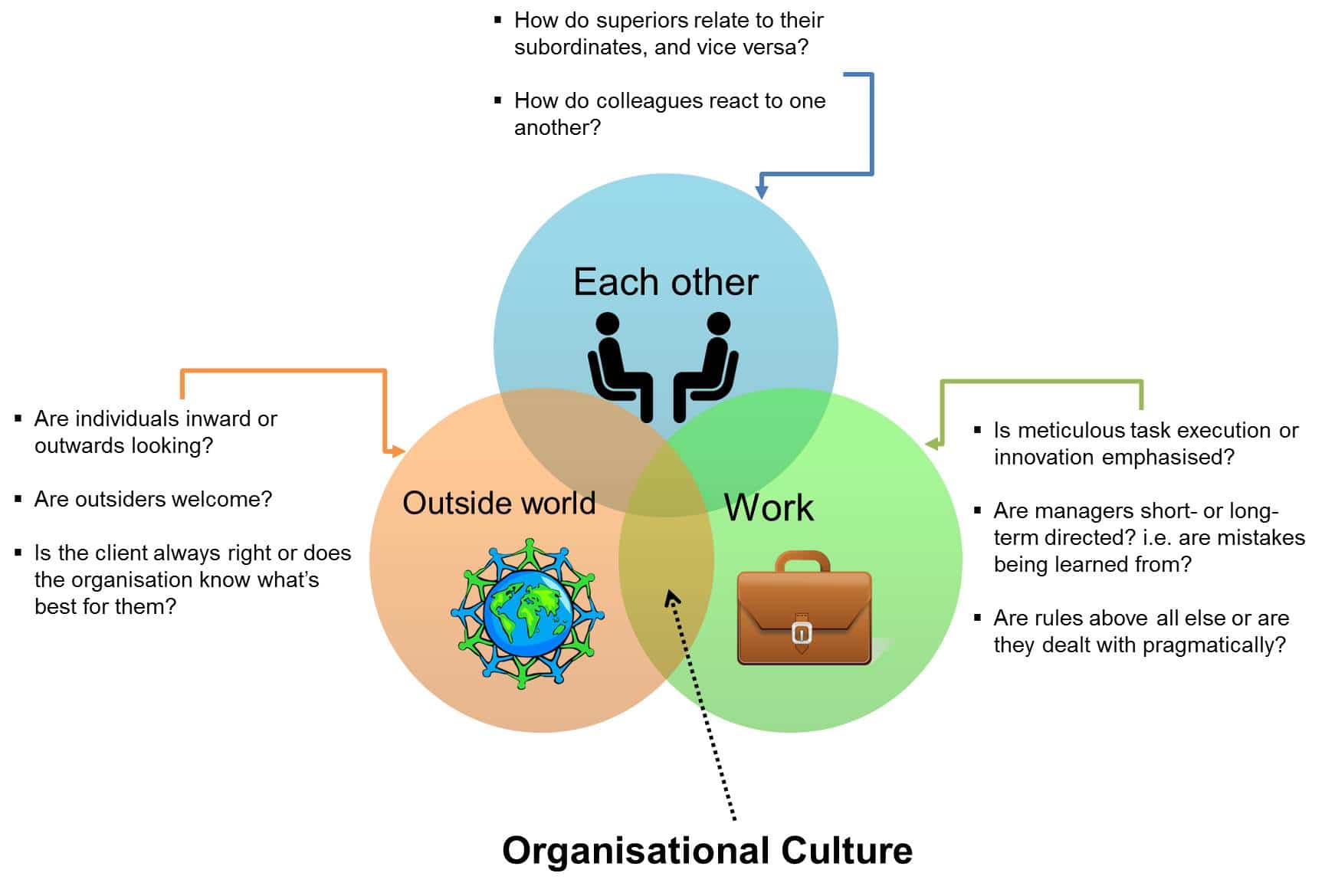What is culture?
When considering culture and its multi-faceted characterisation, one can separate its definition into multiple planes including national and, importantly for this lecture, organisational.
National culture has been described by Geert Hoftstede as being “the collective programming of the human mind that distinguishes one group or category of people from another”. Simply put, culture is what separates one group of individuals from another based on their commonalities which distinguish them from one another.
In the same vein, organisational culture can be defined by referring to collective programming shared by group members such that one group (or organisation) can distinguish itself from another. Organisations, however, are less complex than nations. Whilst national culture is passed down generationally thus facilitating very slow cultural change, organisational culture may be more specific and clear-cut.
National culture, at its core, focuses on values shared between individuals that unite them and separate them from one another. Values steer decision-making and preferences by tapping into strong emotions associated with preferred states of affairs. Thus, according to the national culture theory, groups are distinguished from one another based on values that elicit strong emotions toward a specific decision/state of affairs/situation.
Contrarily, organisational culture focuses on the practices occurring within the organisation to steer decision-making and behaviours toward the preferred state of affairs. Organisations set clear objectives and goals that must achieved in a certain amount of time by performing the required practices. These practices become more tangible than values because they are not fuelled by strong emotions which make the definition of organisational culture more precise and able to be controlled within the work environment i.e. by the CIO, founder, etc.
Below is a table summarising some differences between national and organisational culture.

Organisational culture is inherently comprised of various levels that epitomise and define it, highlighting areas of possible manipulation and improvement for an organisation. These levels have been characterised and together comprise what we defined earlier as practices that are pivotal to core of an organisation’s culture. These levels are illustrated in the diagram below.

What influences organisational culture?
Organisational culture focuses on the interactions of its members with each other, their work, and the surrounding world. These three facets are what distinguish organisations from one another and what influence the way an organisation functions and how well it will function.
Below is a diagram illustrating these interactions and examples associated with them.

Although culture is extremely complex, as shown in the above diagram, it can be manipulated to a certain degree so that it can be mobilised and optimised so that the organisation can function as efficiently as possible.
How to mobilise your organisational culture?
The mobilisation of an organisation’s culture, whilst simple in theory, is extremely complex when trying to apply to a real-life situation. Culture relies on the interactions between individuals; it is based on instinctive, repetitive, and emotional responses that made it difficult to quantify and, thus, change. Despite this, however, organisational leaders may be able to manipulate certain facets of culture to realign it in such a way to benefit the organisation.
If we think of organisational culture as a machine, each facet and level is a gear functioning to move the machine along so that it can function appropriately and effectively. Leaders, CIOs, and founders of organisations should then shift their focus from trying to replace the entire machine to replacing and refining the gears that make up the machine i.e. the multiple facets within organisational culture should be targeted for improvement rather than focusing on changing the entire culture within the organisation. This simplifies the task of mobilising the organisation’s culture to benefit the organisation, its members, and contribute to its success.
These target “gears” for mobilisation are:
- Working within your current cultural situations.
- Changing behaviours.
- Focusing on few, critical behaviours.
- Deploying authentic informal leaders.
- Keeping your formal leaders in check.
- Connecting behaviours with business objectives.
- Demonstrating impact quickly.
- Utilising cross-organisational methods to go viral.
- Aligning behaviours with programmatic efforts.
- Pro-actively managing your cultural situation overtime i.e. long term.
These gears and their interactions are summarised in the diagram below.

Diagram adapted from Katzenbach: 10 Principles of Organizational Culture, Harvard Business Review, Spring 2016
Conclusion
Culture is a vastly characterised and complex entity that relies on the interactions between people, their work, and the outside world. Organisational culture is an important player in the success of an organisation, in that, understanding the six levels of organisational culture allows for the mobilisation of said culture within an organisation. Doing this would allow for the manipulation and management of the culture within an organisation to be more effectively, benefiting the members of the organisation, improving its culture, and contributing to its success.
Further reading
10 Principles of Organizational Culture by Jon Katzenbach, Carolin Oelschlegel, and James Thomas
An organisational cultural perspective by Bob Waisfisz
Next post |
Impact of Culture |
For all our Digital Culture and People Management Lectures.
For all our Podcasts.
